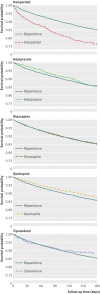Differential risk of death in older residents in nursing homes prescribed specific antipsychotic drugs: population based cohort study
- PMID: 22362541
- PMCID: PMC3285717
- DOI: 10.1136/bmj.e977
Differential risk of death in older residents in nursing homes prescribed specific antipsychotic drugs: population based cohort study
Abstract
Objective: To assess risks of mortality associated with use of individual antipsychotic drugs in elderly residents in nursing homes.
Design: Population based cohort study with linked data from Medicaid, Medicare, the Minimum Data Set, the National Death Index, and a national assessment of nursing home quality.
Setting: Nursing homes in the United States.
Participants: 75,445 new users of antipsychotic drugs (haloperidol, aripiprazole, olanzapine, quetiapine, risperidone, ziprasidone). All participants were aged ≥ 65, were eligible for Medicaid, and lived in a nursing home in 2001-5.
Main outcome measures: Cox proportional hazards models were used to compare 180 day risks of all cause and cause specific mortality by individual drug, with propensity score adjustment to control for potential confounders.
Results: Compared with risperidone, users of haloperidol had an increased risk of mortality (hazard ratio 2.07, 95% confidence interval 1.89 to 2.26) and users of quetiapine a decreased risk (0.81, 0.75 to 0.88). The effects were strongest shortly after the start of treatment, remained after adjustment for dose, and were seen for all causes of death examined. No clinically meaningful differences were observed for the other drugs. There was no evidence that the effect measure modification in those with dementia or behavioural disturbances. There was a dose-response relation for all drugs except quetiapine.
Conclusions: Though these findings cannot prove causality, and we cannot rule out the possibility of residual confounding, they provide more evidence of the risk of using these drugs in older patients, reinforcing the concept that they should not be used in the absence of clear need. The data suggest that the risk of mortality with these drugs is generally increased with higher doses and seems to be highest for haloperidol and least for quetiapine.
Conflict of interest statement
Competing interests: All authors have completed the ICMJE uniform disclosure form at
Figures




Comment in
-
Antipsychotic prescribing in nursing homes.BMJ. 2012 Feb 23;344:e1093. doi: 10.1136/bmj.e1093. BMJ. 2012. PMID: 22362540 No abstract available.
References
-
- Liperoti R, Mor V, Lapane KL, Pedone C, Gambassi G, Bernabei R. The use of atypical antipsychotics in nursing homes. J Clin Psychiatry 2003;64:1106-12. - PubMed
-
- Briesacher BA, Limcangco MR, Simoni-Wastila L, Doshi JA, Levens SR, Shea DG, et al. The quality of antipsychotic drug prescribing in nursing homes. Arch Intern Med 2005;165:1280-5. - PubMed
-
- Bronskill SE, Anderson GM, Sykora K, Wodchis WP, Gill S, Shulman KI, et al. Neuroleptic drug therapy in older adults newly admitted to nursing homes: incidence, dose, and specialist contact. J Am Geriatr Soc 2004;52:749-55. - PubMed
-
- Rochon PA, Stukel TA, Bronskill SE, Gomes T, Sykora K, Wodchis WP, et al. Variation in nursing home antipsychotic prescribing rates. Arch Intern Med 2007;167:676-83. - PubMed
Publication types
MeSH terms
Substances
Grants and funding
LinkOut - more resources
Full Text Sources
Other Literature Sources
Medical
